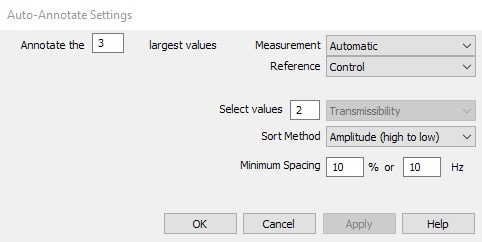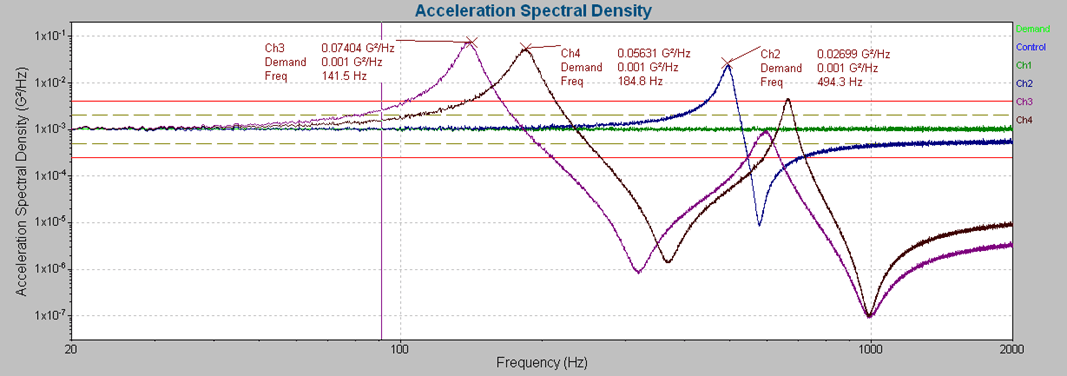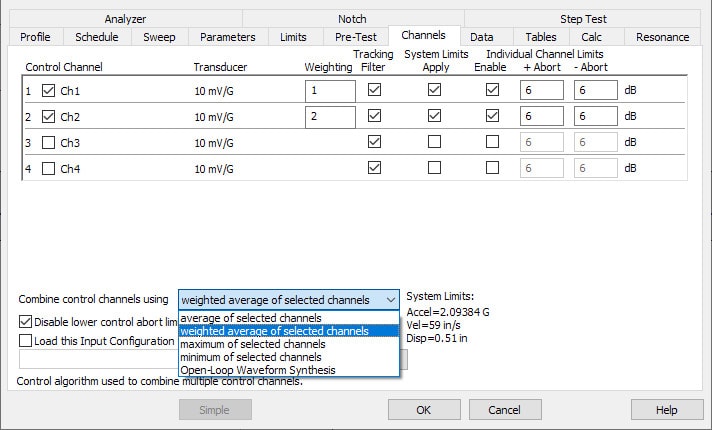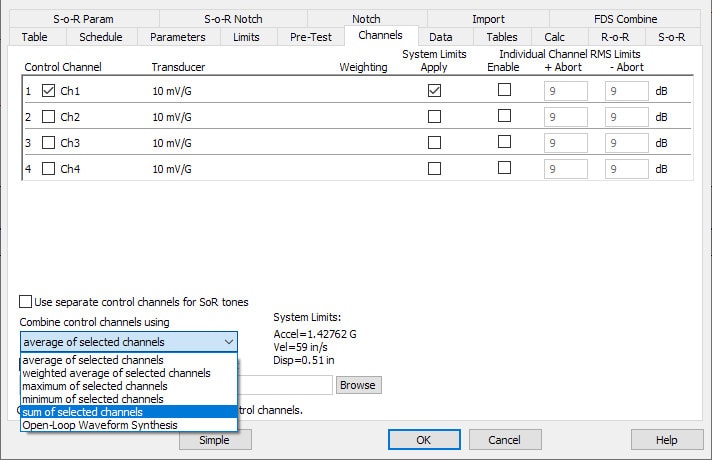A new version of VibrationVIEW (2021.1) is available for download. In this latest software release, access additional weighting options for multi-channel control, notching at a calculation, and more.
Sine
Specify Weighting on Multi-Channel Control
In Sine, the user can choose the algorithm used to combine multiple control channels. An engineer may employ multi-channel control for recording multiple planes simultaneously or optimizing the time for testing, among other reasons. Under the Channels tab, select the control channels and point to the Combine control channels using the drop-down list.
New to VibrationVIEW is the option to weigh the average of the selected channels. The weighted average of selected channels allows the user to assign different weights to each channel. The software uses the weights to calculate the weighted mean values of all the control channels.
The weighted mean value is used as the control, and the assigned weight is relative. For example, if Ch1 has a weight of 3, and Ch4 has a weight of 1, the weighted average is 3/4 Ch1 + 1/4 Ch4.
The other drop-down options are:
- “Average of selected channels” uses the mean value of the selected control channels as the control.
- “Maximum of selected channels” sets extremal control by taking the maximum value of the selected control channels.
- “Minimum of selected channels” uses the lowest possible value of the selected control values.
- “Open-Loop Waveform Synthesis” disables the control algorithm and outputs an uncompensated voltage reference signal. This option is a special analyzer mode and requires the analyzer software package.
Random
Notch at a Calculation
For a random test in VibrationVIEW version 2021.1 and newer, the user can use an equation to limit the drive signal. The software compares the equation to the limit and then adjusts the drive to keep the calculation lower than the limit.
![]()
In the case of force limiting, the user can sum the output of several force transducers and notch on the total force applied to the structure. VibrationVIEW defines the limit in the frequency domain and performs notching in the frequency domain.

The notch limit can be a dB level above the demand or a user-defined table. If the limit is above the demand, the software assumes the calculation’s unit is the same as the demand. If the limit is a table, the calculation is assumed to have the same unit as the table.
Summation of Control Channels
In Random, VibrationVIEW can multiply control channels using their average value. The software takes the weighted average of all selected control channels uses the value as control.
In version 2021.1, the software can calculate the sum of selected channels without averaging. This feature is particularly beneficial when using a triaxial accelerometer, which measures vibration in three linear directions. The sum of the selected channels will display the overall acceleration from all directions.
Under the Channels tab, select the control channels and point to the “Combine control channels” using the drop-down list.
Resonance Table Report Parameter
In Random test mode, the new [ResTable] report parameter displays the peak resonances on a PSD graph. The user can configure resonance peak detection under Cursor > Auto-Annotate Settings and add the report parameter [PARAM:ResTable] to a report template file.

The user can select the channel(s) that will be evaluated for resonance peaks or set the measurement to automatic for all channels.
The software identifies the resonance peaks by comparing the transmissibility of the measurement and reference traces. The user can also select the reference channel(s).
Additional settings include:
- Set the lower limit of transmissibility for annotation.
- Select the order of the peaks on the graph.
- Define the minimum distance between the detected peaks.

Random graph with peak resonance annotations.
Wait for Remote I/O Schedule Level
The new schedule level “Wait for signal” pauses the test until the system receives the “Continue from wait” remote input signal type (Sine, Random, and Shock test modes).
Additional Report Parameters
In addition to the Random [ResTable] parameter, version 2021.1 includes report parameters for maximum profile AVD values in Sine:
- [PARAM:DemandProfileMax]
- [PARAM:DemandVelocityPeakProfileMax]
- [PARAM:DemandDisplacementProfileMax]
Additionally, the user can add Trigger Channels to an SRS report. A skewness parameter to meet standard IEC 60068-2-64 (2008+A1:2019) has also been added.
New VR10500 Configurations

Additional developments to support the VR10500’s 512 channel count have been completed. Of note, the VR10500 now supports eight and twelve-channel configuration options (previously increments of 16 only). The configurations are as follows: 8, 12, 16, 20, 24, 28, and 32. After 32 channels, the channel count increases by increments of 16. The VR9500 is still the best option for four-channel-count systems.
Download VibrationVIEW 2021.1
VR customers with a valid Upgrades and Support Agreement (U&SA) can upgrade to the latest version for free. The demo version is available to any user for free.


